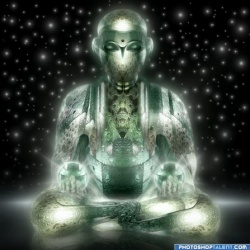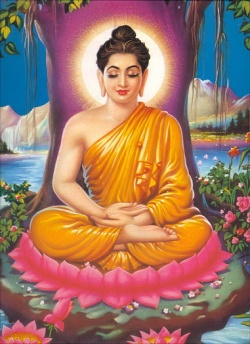The Vijnanvada Conception Of ''Consciousness-Only''
Vijnanavada gets its name ("consciousness teaching", or "Consciousness-ism") from its theory of a psychological emanation from an original universal consciousness (usually called the Alaya-vijnana). It is in fact the only Buddhist school that incorporated emanationist ideas; especially in later, Sinicized form.
According to the Lankavatara Sutra, all the three worlds (of Desire, Pure Form, and Formlessness) are the result of subjective imagination (vikalpa). No external objects exist in reality; only consciousness Chandradhar Sharma, A Critical Survey of Indian Philosophy, p.109], reality being "mind-only" (Cittamatra).
A similarity can be pointed out here with the eigh-teenth century Scottish empirical philosopher Bishop George Berkeley, who argued that no objective physical reality exists at all; the world being a sort of collective dream, and God as the over-consciousness holding the whole thing together. Not surprisingly, in the materialistically orientated West, Berkely's philosophy (which came to be called "Idealism", although it has little in common with the Idealism (Idea-ism) of Plato) did not really catch on.
In the Lankavatara, as with Berkeley, the consciousness in which all things exist is not individual consciousness but Absolute Consciousness.
This Absolute Consciousness (Berkeley's "God") is the immortal and unchanging consciousness that transcends duality, and is realized through transcendent Knowledge (jnana) [Dr Chandradhar Sharma, A Critical Survey of Indian Philosophy, pp.110-111]. It is variously termed the Alaya-vijnana (storehouse consciousness), Chitta (Mind), or Tathagata-garbha (Womb or Seed of the Buddhas - which is not an ontological reality but rather the potential or seed or cause leading towards enlightenment [[[Whalen Lai]], "The Meaning of "mind-only" (wei-hsin): An analysis of a sinitic Mahayana phenomenon", Philosophy East and West 27, no 1; p.74]).
The Alaya-vijnana is the universal storehouse consciousness, so-called because it is the repository of the vasanas, the impressions or tendencies carried over from past lives. As D. T. Suzuki ex-plains, "every act, mental or physical, leaves its seeds (bijas) behind, which is planted in the Alaya for future germination under favourable conditions" [[[Wikipedia:D. T. Suzuki|D. T. Suzuki]] Studies in the Lankavatara Sutra, p.483].
Through the activity of vasanas, the seven individual consciousnesses - the five sense-consciousnesses, the manovijnana or mind-consciousness, and the klishto-manovijnana or "defiled mind-consciousness" - arise from the Alaya-vijnana like waves from the ocean [[[Chandradhar Sharma]], A Critical Survey of Indian Philosophy, pp.111].
In the systematised Yogachara school of Maitreyanatha, Asanga and Vasubandu, the pristine Absolute Consciousness or Vijnaptimatrata is the Absolute Reality.
Through individual Ignorance (Avidya), Vijnaptimatrata appears as the three vijnanas; viz:
Alayavijnana, Manas or Klishto-manovijnana, and Pravritti-vijnana,
by which is meant the six consciousnesses - the five sense-consciousnesses (seeing, hearing, etc) and the manovijnana or mind-consciousness - that make up mental and sensory reality [[[Wikipedia:Ashok Kumar Chatterjee|Ashok Kumar Chatterjee]], The Yogachara Idealism, p.87].
Here the Alayavij-nana is no longer the Absolute but one of the facets of relative Consciousness; the repository of the vasanas or bijas. As Chatterjee explains, "none of these eight vijnanas is ultimate.
Consciousness is disturbed owing to the impact of a wrong idea", and once this is eliminated and the agitation calmed down, consciousness "regains its eternal quiescence" [Ibid p.107].
There is the parallel here with (and obviously a derivation from an early form of) Samkhya, in which the purusha or consciousness-principle is distinct from the principles of nature and psycho-physical existence (or prakriti).
The difference is that whereas Samkhya implies of multiplicity of consciousnesses, Yogachara, like Advaita Vedanta, refers to only one, which is also the underlying substratum of existence. It is not the case that Advaita influenced Yogachara however; more the reverse.
In the Yogachara psycho-metaphysics, it is the Klishto-manovijnana, or Manas, that is the cause of the false idea of a separate "I" or self or ego.
Through the intellectual activity (manana) of this "defiled mind-consciousness" the vasanas that are latent and indeterminate in the Alayavijnana are actualized, or come into consciousness, and take the form of objects of the senses Ashok Kumar Chatterjee,
The Yogachara Idealism, pp.102-3]. Creation is therefore cyclic. The Alayavijnana is the receptacle of vasanas or impressions from past vijnanas, and in turn generates further vijnanas through the ripening of vasanas [Ibid p.88]. The cycle of karmic forces and their actualisation is an infinite one, like the cycle of the tree and its seed [Ibid p.107].
In its sequence of vijnanas there is an obvious parallel between Buddhist emanationism (Vijnanavada) and Hindu emanationism (Samkhya) with its unfolding tattwas.
But Vijnanavada or Yogachara replaces the Samkhyan dualism with monism by reuniting the disparate purusha and prakriti in the single Alaya-vijnana, but otherwise follows the Samkhyan ontology.
As in Samkhya there is the emanation from an original but undifferentiated universal state (Alayavijnana = Prakriti = Buddhi) through the mediating state of separative egotism (Klishto-manovijnana = Ahamkara) to manifold phenomenal reality (manas and the senses).

